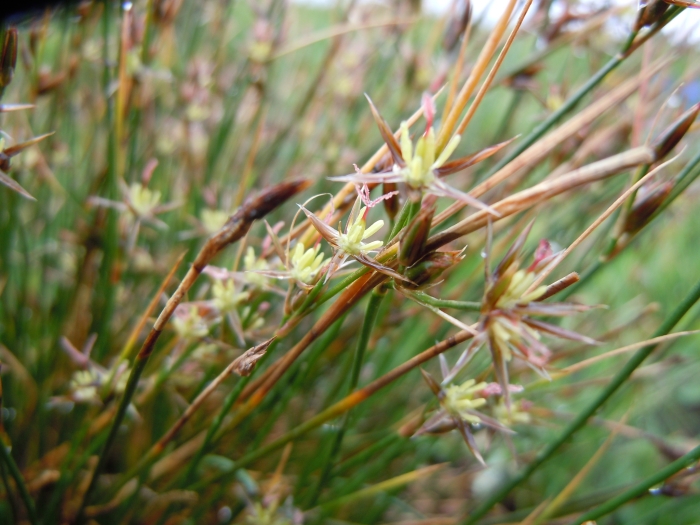Drummond’s Rush
(Juncus drummondii)
Drummond’s Rush (Juncus drummondii)
/
/

Matt Lavin
CC BY 4.0
Image By:
Matt Lavin
Recorded By:
Copyright:
CC BY 4.0
Copyright Notice:
Photo by: Matt Lavin | License Type: CC BY 4.0 | License URL: http://creativecommons.org/licenses/by/4.0/ | Rights Holder: Matt Lavin | Publisher: iNaturalist | Date Created: 2010-08-22T12:39:26-07:00 |

























Estimated Native Range
Summary
Juncus drummondii, commonly known as Drummond’s rush, is a perennial herb native to a variety of moist habitats in western North America, including wet coniferous forests, alpine meadows, and slopes from northern Canada and Alaska to New Mexico. It typically forms narrow, erect tufts reaching up to 16 inches in height. The basal leaves are reduced to sheaths that wrap around the stem, a common adaptation in wet environments. Drummond’s rush produces an inflorescence on the side of the stem toward the top, characterized by a long, cylindrical bract that extends beyond the flowers. The flowers themselves have thick tepals that are dark brown with a green stripe and transparent margins, and they give way to a capsule fruit.
Drummond’s rush is valued for its textural interest in water gardens, rain gardens, and as a component of naturalized plantings in wet areas. It thrives in full sun to part shade and prefers consistently moist to wet soils. While it is not typically used for ornamental purposes, its resilience and ability to stabilize soil make it useful for restoration projects and erosion control. It is also of ecological importance, providing habitat and food for various wildlife species. Gardeners should be aware that in ideal wet conditions, it can spread vigorously, potentially becoming invasive.CC BY-SA 4.0
Drummond’s rush is valued for its textural interest in water gardens, rain gardens, and as a component of naturalized plantings in wet areas. It thrives in full sun to part shade and prefers consistently moist to wet soils. While it is not typically used for ornamental purposes, its resilience and ability to stabilize soil make it useful for restoration projects and erosion control. It is also of ecological importance, providing habitat and food for various wildlife species. Gardeners should be aware that in ideal wet conditions, it can spread vigorously, potentially becoming invasive.CC BY-SA 4.0
Plant Description
- Plant Type: Grass
- Height: 1-2 feet
- Width: 1-1.5 feet
- Growth Rate: Slow
- Flower Color: N/A
- Flowering Season: Summer
- Leaf Retention: Evergreen
Growth Requirements
- Sun: Full Sun, Part Shade
- Water: Medium
- Drainage: Fast, Medium
Common Uses
Border Plant, Erosion Control, Low Maintenance, Water Garden
Natural Habitat
Native to a variety of moist habitats in western North America, including wet coniferous forests, alpine meadows, and slopes
Other Names
Common Names: Drummond’s Rush, Mountain Rush
Scientific Names: , Juncus drummondii, Juncus arcticus var. gracilis, Juncus compressus var. subtriflorus, Juncus drummondii f. davisonii, Juncus drummondii var. drummondii, Juncus drummondii var. humilis, Juncus drummondii var. logifructus, Juncus pauperculus,
GBIF Accepted Name: